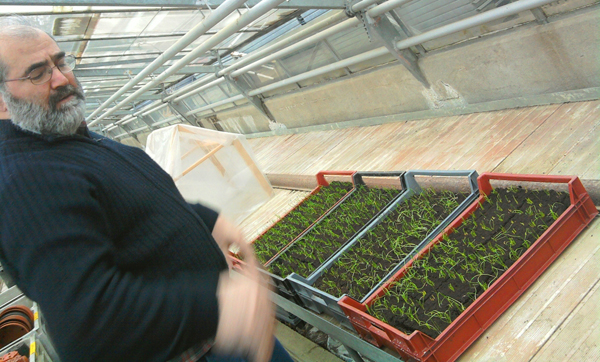A cooperative in Switzerland is developing a consumer-supported agriculture system to which consumers pay a periodic fee. Consumers are also required to farm the land for a number of hours per year.
There isn’t much growing on the two and a half hectares of land in Ziplo, Geneva, save for small plots of lettuce here and there and a few herbal plants. As Switzerland transitions from winter to spring, the activities of the Jardin du Chorroton cooperative are quiet as the farmers wait for prime growing season.
 “This land actually doesn’t belong to the farmers or consumers,” says Irene (29). “Four years ago we claimed this land because it was abandoned.” She explains that in the past the land was used for conventional farming, using pesticides and other chemicals. “The farm next to us still uses these conventional techniques (pointing to the border of the two lands); the difference is like life and death.”
“This land actually doesn’t belong to the farmers or consumers,” says Irene (29). “Four years ago we claimed this land because it was abandoned.” She explains that in the past the land was used for conventional farming, using pesticides and other chemicals. “The farm next to us still uses these conventional techniques (pointing to the border of the two lands); the difference is like life and death.”
The land adjacent to Jardin du Chorroton is owned by immigrant workers from Portugal. The visual difference between this land and the property cared for by Irene is striking; it appears dry and barren.
There are 140 family members of the cooperative under the umbrella organization of Uniterra, a member of the small farmer organization La Via Campesina (International Peasant Movement). In 2007 La Via Campesina formed the cooperative with farmers to cultivate the land through consumer-supported agriculture.
 The unique aspect of this system is that consumers must pay in advance a sum of 1,400 Swiss Francs (around US$ 1,475) per year. This capital is used to plant on the land, and the variety of crops to be planted is pre-approved by cooperative members. In this way, the farmers who work the land—there are around six people, Irene among them—receive a secure monthly salary.
The unique aspect of this system is that consumers must pay in advance a sum of 1,400 Swiss Francs (around US$ 1,475) per year. This capital is used to plant on the land, and the variety of crops to be planted is pre-approved by cooperative members. In this way, the farmers who work the land—there are around six people, Irene among them—receive a secure monthly salary.
The cooperative collective bears the burden of any risk to the harvest. Ipso facto if a surplus of produce is harvested, consumers receive more, and if output declines, as in the winter season, consumers will receive less. All the harvested produce is packaged in baskets and distributed by the cooperative each week to drop points around the city of Geneva.
Individual consumers retrieve their own baskets of produce. Additionally, they are required to spend 16 hours a year farming the land. “The consumers need to be aware [of the process] so they can really be a part of this system,” explains Irene.
Irene says that there are many families in Geneva who want to be a part of this new style of cooperative; but due to quality control measures and limited production on this small plot of land, the cooperative has had to turn down some requests for membership. Luckily, dozens of cooperatives in Switzerland have also adopted these consumer-supported agricultural systems.
At Jardin du Chorroton, almost all of the management employs mechanized systems for farming. Ten well-constructed greenhouses complete with irrigation systems are erected on the property. Farmers use a variety of tools, from simple hand tractors to large tractors and machines for turning and loosening the soil, and shape garden beds for planting are all employed.
Farming methods are based on sustainable farming systems; therefore, there are also mechanized systems for moving compost and processing waste. “One of my friends who works here is crazy about machines,” says Irene, laughing.
One traditional technique Jardin du Chorroton continues to preserve is horse-drawn ploughs. The horses they own plough the land, transport produce, and are even used during demonstrations. In fact, the cooperative’s name is derived from horse-powered farming techniques: In the local language chorroton translates to “horse-drawn carriage.”
This afternoon a consumer is harvesting sage herbs from one of the garden beds. Usually, on the weekends, consumers will bring their families, especially their children, to learn and play at Jardin du Chorroton.
This model of a producer/consumer cooperative for food production is actually increasingly popular all over the world. In addition to Switzerland, the countries of Japan, the United States, and Spain all boast rising Community Supported Agriculture movements. If product prices are compared with store-bought items, the cost of cooperative produce is similar; but cooperative farming offers the additional benefit of support for local products, allows consumers to know the quality of their food, and offers a short chain of sale.
From the farmer’s perspective, cooperatives provide a guaranteed income and, as a result, a secure source of livelihood hard to come by in today’s market. Farmers are also protected from risks such as crop failure or market price fluctuation.
Can a system like this be developed within our local farmers’ organizations? Is it possibly to spread this idea more widely across Indonesia?
Written by the Head of Foreign Affairs for the Indonesian Peasants Union (SPI – Serikat Petani Indonesia). This article was written in conjunction with in-country activities to advocate for small farmer’s rights during the 16th Human Rights Council of the United Nations in Switzerland, March 2011.













